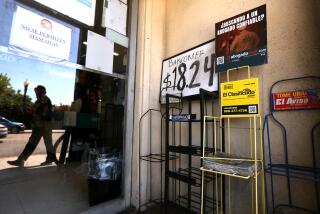East Bloc Editors Take a Page From U.S. Media : Magazines: Fifteen journalists have come to America to learn how a free and competitive press works.
- Share via
NEW YORK — When Lukasz Malachowski edited an influential weekly back home in Poland, the bottom line was maintaining journalistic integrity while avoiding the ire of Communist government censors.
Came the revolution and all that changed. The censors were gone, but so were the government subsidies for essentials such as paper and ink. Competing for survival became the new bottom line.
“Everything was subsidized or donated. We never had to think whether it could be sold or not. . . . Now we have to think over all these things or nobody will be able to survive,” says Malachowski, 35, whose Catholic Weekly Review essentially went broke with the change to a market economy.
Malachowski is one of 15 Eastern European journalists spending 10 weeks at American magazines such as Elle, Rolling Stone, Business Week, Family Circle and Esquire in an internship program sponsored by the U.S. government and the magazines.
The interns, seasoned journalists in their mid-30s from Bulgaria, Czechoslovakia, East Germany, Hungary, Poland and Romania, have come to the United States to learn how a free and competitive press works.
“They have to learn to operate a magazine as a business,” says Anne Sutherland Fuchs, senior vice president and publisher of Elle, who organized the magazine industry’s role in the internship program.
“They haven’t been faced with circulation decisions, subscription-pricing decisions . . . advertising rates. Everything has been dictated--whether it’s the kind of paper they print on or how many copies they print,” she says.
“It’s a whole different ballgame when it’s a free press.”
Sitting in his cubicle at Elle magazine, Peter Janos Sos, 41, leafed through a copy of Kepes 7 (Illustrated Week), the Hungarian family weekly of which he is deputy editor-in-chief. The first advertisement in the 60-page magazine appeared on Page 30; it promoted paving stones.
Then he turned the glossy pages of an issue of Elle filled with ads enticing the reader to buy expensive cosmetics, designer clothing, glamorous perfumes and chic accessories.
“At first I thought the quality of advertisements is not the job of the editor but the job of the advertiser,” says Sos, a burly man who chooses his English words carefully. “I talked about it with Anne Fuchs and she said, ‘I would never take the advertisement of X here on the first pages because it’s not beautiful enough.”’
The Eastern European journalists admire the sleek look of their host publications, their advertising know-how and technical expertise. Above all, they admire the huge sums of money that go into making the magazines. They are also fiercely proud of their magazines at home. But this pride goes hand in hand with a deep frustration about their financial and technical limitations.
Gyorgyi Kocsis, 36, an intern at Business Week, helped found a weekly economic magazine 12 years ago in Budapest, Hungary, that broke new ground in up-to-date, critical reporting at a time when most publications were mouthpieces for the government.
HVG, the Hungarian initials for World Economy Weekly, became “a very popular quality magazine in Hungary,” says Kocsis. But in the last two years, she added, as new newspapers and magazines hit the market, it lost 15% of its readership and suffered an “identity crisis.”
She pointed to a recent issue of her magazine on her cluttered desk at Business Week. The cover shows pieces of paper representing stock shares coming out of factory chimneys. The illustration is in black and white, printed on rough paper.
“Some of our ideas on the cover--gags, pictures--can be on any world magazine. But I have to look with a looking glass because the printing is so awful,” says Kocsis. HVG’s look suffers badly in comparison to “all the beautiful magazines on the newsstand here.”
Suddenly, unable to contain her frustration, she gestures toward her magazine and exclaims, “Now, I hate it!”
But as the Eastern European magazines get slicker and fatter with advertisements and censorship becomes a thing of the past, even journalists who are ardent supporters of a free-market economy feel a bittersweet twinge as their old world collapses.
The “family business” atmosphere at HVG probably will disappear, Kocsis says wistfully.
“Probably it will be more professional and big and sort of Westernized. We will lose this feeling. We are going to be news factory, which can be good and useful and profiting, but probably we will lose this friendly atmosphere, I think. But we have to grow up.”
Malachowski, interning at Family Circle, recently lost his job as a top editor at the Catholic Weekly Review in Warsaw. As the only independent Polish newspaper tolerated by the Communist Party, its coverage of politics and social issues was very influential, he says.
Today, the Catholic Church, trying to cope in a free-market economy and pay its bills, has let the weekly become a slim pamphlet on religious affairs, Malachowski says.
“We always treated our press as a sort of art piece and now we must start to think about this as a sort of product,” says Malachowski, whose wire-rimmed glasses and tweed jacket reinforce his professorial air.
Anyway, he adds, people aren’t as interested in art anymore. Poetry, he notes, thrived in the 1960s and ‘70s in Poland when government censorship was extremely strict.
“The problem is that today you have no censorship, but much less people are interested in poetry,” he says. “A new generation thinks about commercial things--about houses, cars, about normal things as they are in the whole Western world.
“The condition of the economy in Poland gives us an absolutely new situation,” says Malachowski. “The press is (financially) bankrupt. It is difficult to survive with magazines and papers. We need to see the average American paper or magazine to find out how it works.”
American know-how goes a long way. But it doesn’t translate directly into hard currency. The survival of Eastern European magazines and newspapers also depends on Western companies investing in them. HVG, Kepes 7 and Mlady Svet, the largest weekly in Czechoslovakia, all have made deals with foreign companies or are close to doing so.
Mlady Svet (Young Word) takes three weeks to produce, complains Marek Hlavica, 28, an editor at the weekly. He also is a singer and harmonica player and is spending his internship at Rolling Stone magazine.
If his magazine, founded by the youth group of the Communist Party, is to stay ahead of its growing pack of competitors, he says, it needs an infusion of money from foreign investors to upgrade its technical capabilities.
“The magazine is one stone in the mosaic of the whole society, and it must change with those things--politics, society and so on,” Hlavica says.
“But we are optimists. We’ve got a good starting position. That’s very important. We’ve got tradition, good tradition. We’ve got good writers. We’ve got opportunity to cooperate with foreign companies. So we are optimists. Why not?”
More to Read
Sign up for Essential California
The most important California stories and recommendations in your inbox every morning.
You may occasionally receive promotional content from the Los Angeles Times.










